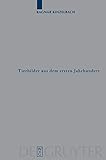Tierbilder aus dem ersten Jahrhundert : Ein zoologischer Kommentar zum Artemidor-Papyrus / Ragnar Kinzelbach.
Material type: TextSeries: Archiv für Papyrusforschung und verwandte Gebiete – Beihefte ; 28Publisher: Berlin ; Boston : De Gruyter, [2009]Copyright date: ©2009Description: 1 online resource (139 p.) : 46 TafContent type:
TextSeries: Archiv für Papyrusforschung und verwandte Gebiete – Beihefte ; 28Publisher: Berlin ; Boston : De Gruyter, [2009]Copyright date: ©2009Description: 1 online resource (139 p.) : 46 TafContent type: - 9783110225808
- 9783110225815
- 888/.0102 22
- online - DeGruyter
- Issued also in print.
| Item type | Current library | Call number | URL | Status | Notes | Barcode | |
|---|---|---|---|---|---|---|---|
 eBook
eBook
|
Biblioteca "Angelicum" Pont. Univ. S.Tommaso d'Aquino Nuvola online | online - DeGruyter (Browse shelf(Opens below)) | Online access | Not for loan (Accesso limitato) | Accesso per gli utenti autorizzati / Access for authorized users | (dgr)9783110225815 |
Browsing Biblioteca "Angelicum" Pont. Univ. S.Tommaso d'Aquino shelves, Shelving location: Nuvola online Close shelf browser (Hides shelf browser)
Frontmatter -- Inhaltsverzeichnis -- 1. Einleitung -- 2. Der Artemidor-Papyrus -- 3. Die Tierzeichnungen des Verso: Ziele und Methoden -- 4. Kommentare zu den Arten -- 5. Konzept und Zeichner -- 6. Schlussfolgerungen -- 7. Zusammenfassung -- 8. Abstract -- Backmatter
restricted access online access with authorization star
http://purl.org/coar/access_right/c_16ec
Die Rückseite des im frühen ersten Jahrhundert n. Chr. in Alexandria entstandenen Artemidor-Papyrus zeigt 41 Zeichnungen von einer Hand, davon 38 Tierdarstellungen (da oft zwei Arten umfassend, insgesamt 44 Tiere), von denen die meisten mit griechischen Tiernamen versehen sind. Nach einer „Überschrift“ auf dem Papyrus enthält er Vierfüßer des Landes, Vögel, Fische und Wale. Es ist kein Ordnungsprinzip zu erkennen, außer dass größere Tiere von besonderem Seltenheitswert dargestellt werden, aus vielen Taxa: Ein Krebs, fünf Fischartige, sechs Reptilien sensu lato, elf Vögel, siebzehn Säugetiere. Die Darstellung steht in einer hellenistischen Tradition von Tierbildern, beginnend mit Aristoteles, ausgebaut durch die Vorläufer des Nil-Mosaiks von Praeneste (Palestrina), fortgesetzt einerseits in der hellenistisch-römischen Kunst (Wandgemälde, Mosaiken), andererseits in „wissenschaftlichen“ byzantinischen Codices. Das Verso des Papyrus wurde offensichtlich als Musterbuch benutzt.
The Artemidorus papyrus, originating from Alexandria at the beginning of the 1st century A. D., contains on its verso 41 drawings by one hand, thereof 38 sketches of animals (some comprising two species each, thus resulting in 44 species), most of them labelled with their Greek names. As visible from the ‛title’ on the papyrus itself, it presents terrestrial tetrapods as well as birds, fish, and whales. No ordering principle can be identified, except the preference of especially rare and impressive creatures. They belong to different animal taxa, i.e. crustaceans (1), fish (5), reptiles (6), birds (11), and mammals (17). The work as a whole stands in the tradition of Hellenistic animal pictures, beginning with Aristotle, developed further by the forerunners of the Nile Mosaic of Praeneste (Palestrina), and continued in Hellenistic and Roman artwork (wall paintings, mosaics) as well as in ‛scientific’ Byzantine codices. Most probably, this part of the papyrus was used as a collection of specimen.
Issued also in print.
Mode of access: Internet via World Wide Web.
In German.
Description based on online resource; title from PDF title page (publisher's Web site, viewed 28. Feb 2023)









